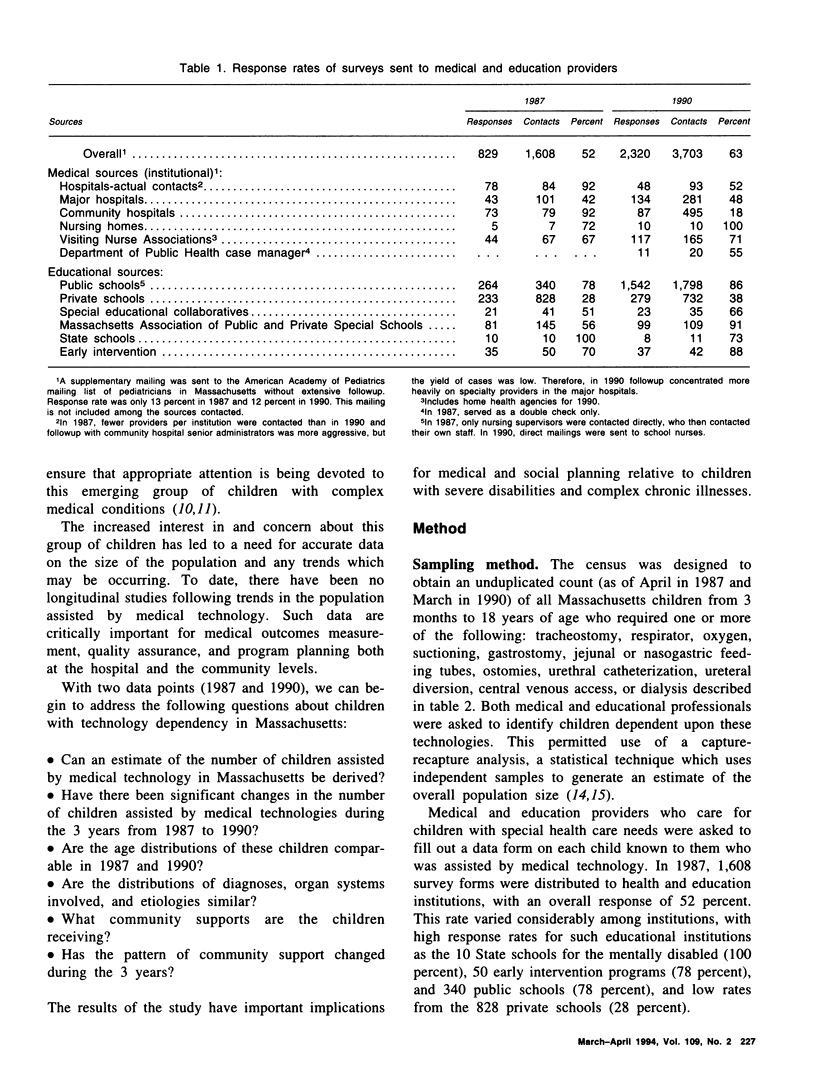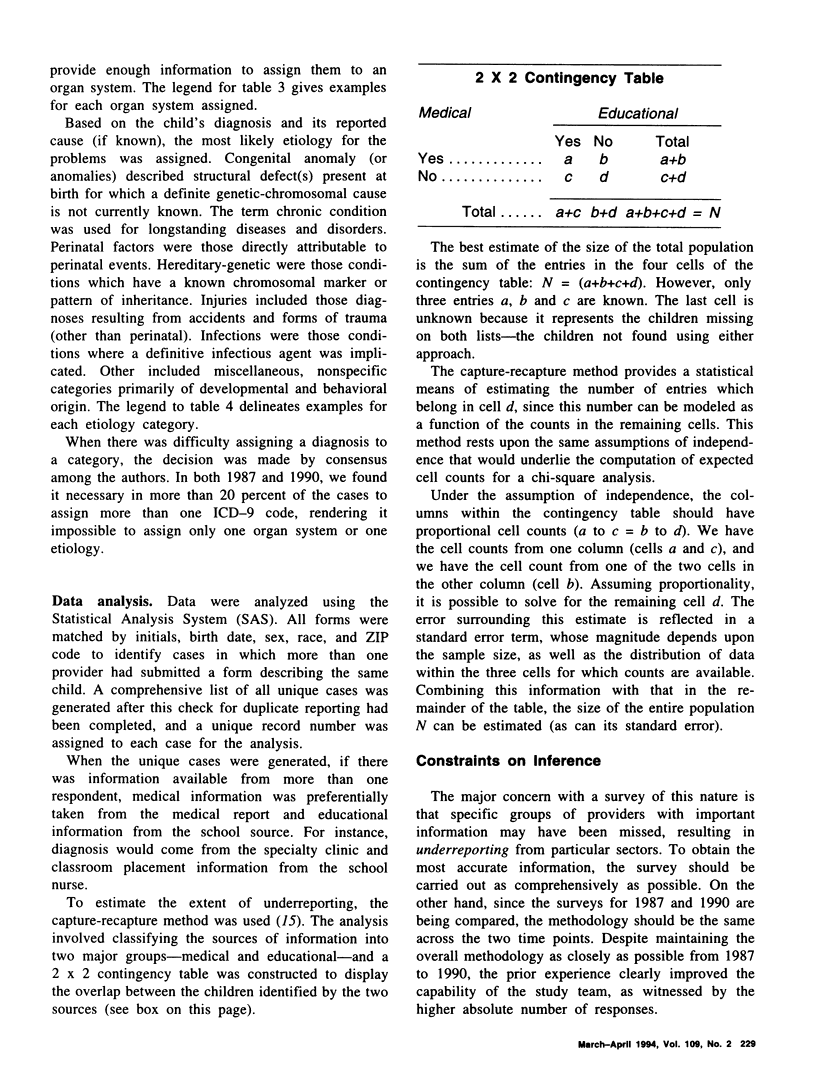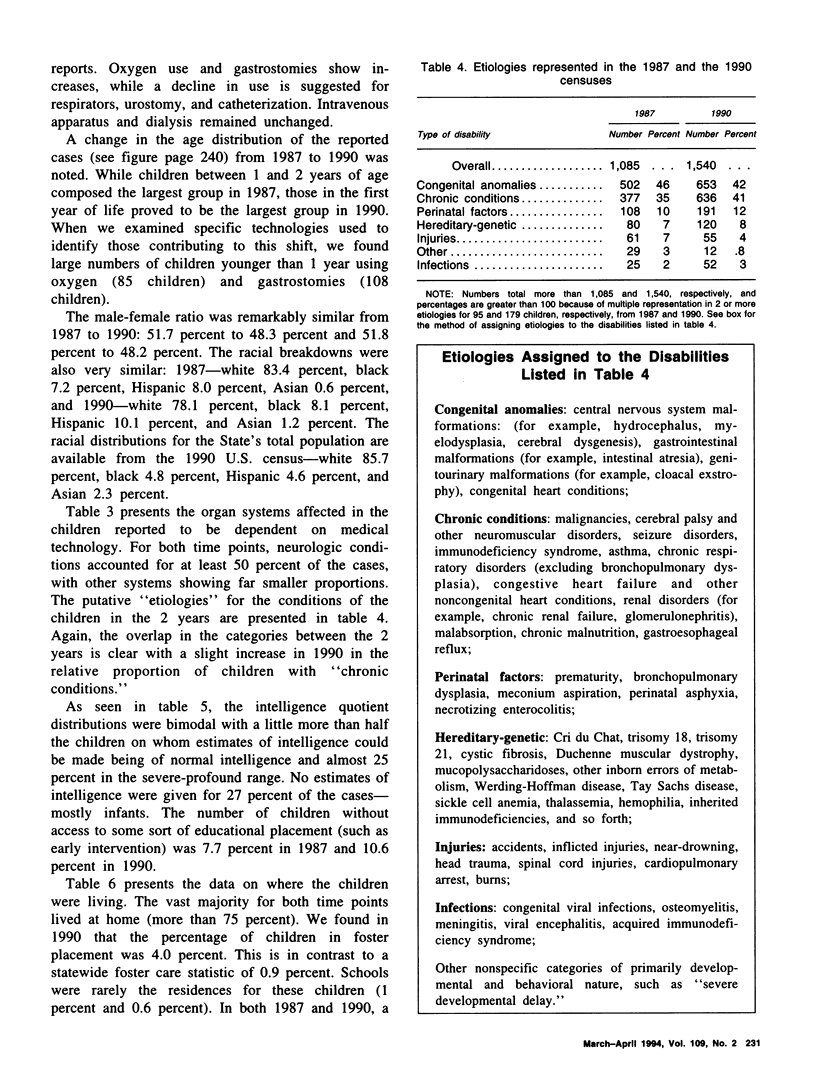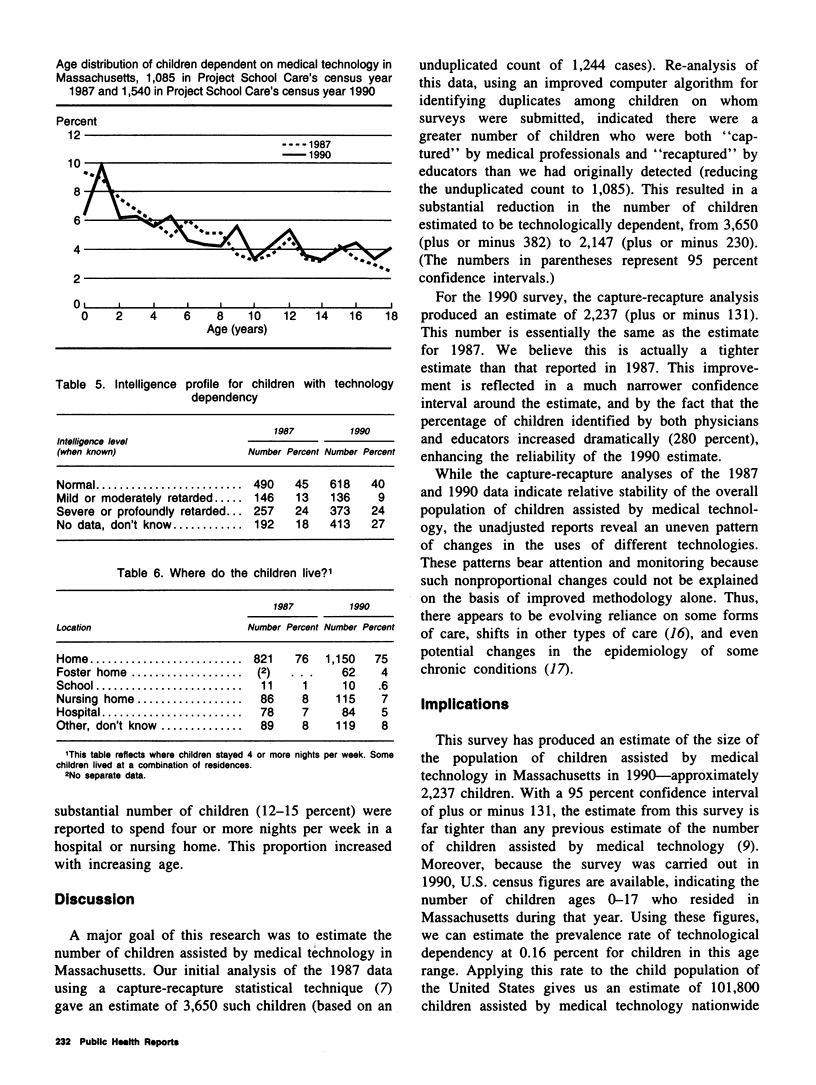Abstract
In 1987 and 1990 in Massachusetts, surveys were conducted to determine the size, pattern of distribution, and trends in the population of children assisted by medical technology. The authors obtained an unduplicated count of all Massachusetts children from 3 months to 18 years of age who used one or more of the following: tracheostomy, respirator, oxygen, suctioning, gastrostomy, jejunal or nasogastric feedings, ostomies, urethral catheterization, ureteral diversion, intravenous access, or dialysis. By comparing counts obtained from medical and educational sources, the authors were able to perform a capture-recapture analysis to estimate the overall number of children dependent upon these technologies. The number of children identified in our surveys increased from 1,085 in 1987 to 1,540 in 1990. However, the capture-recapture analysis yielded estimates of 2,147 plus or minus 230 for 1987 and 2,237 plus or minus 131 for 1990. This suggests that the population of children dependent upon medical technology was essentially stable during this period, and that the 42 percent increase in the number of children identified in our survey reflected improved sampling techniques. During the 3 years, shifts in the pattern of technology use were noted, however. Use of oxygen and gastrostomy increased, and urostomy use declined. A change in the age distribution of the children was also documented, with a shift in the preponderence of technology use from 12 to 24 months in 1987 to children in the first year of life in 1990.(ABSTRACT TRUNCATED AT 250 WORDS)
Full text
PDF







Selected References
These references are in PubMed. This may not be the complete list of references from this article.
- Avery M. E., Tooley W. H., Keller J. B., Hurd S. S., Bryan M. H., Cotton R. B., Epstein M. F., Fitzhardinge P. M., Hansen C. B., Hansen T. N. Is chronic lung disease in low birth weight infants preventable? A survey of eight centers. Pediatrics. 1987 Jan;79(1):26–30. [PubMed] [Google Scholar]
- Burr B. H., Guyer B., Todres I. D., Abrahams B., Chiodo T. Home care for children on respirators. N Engl J Med. 1983 Nov 24;309(21):1319–1323. doi: 10.1056/NEJM198311243092112. [DOI] [PubMed] [Google Scholar]
- Cairo M. S., Spooner S., Sowden L., Bennetts G. A., Towne B., Hodder F. Long-term use of indwelling multipurpose silastic catheters in pediatric cancer patients treated with aggressive chemotherapy. J Clin Oncol. 1986 May;4(5):784–788. doi: 10.1200/JCO.1986.4.5.784. [DOI] [PubMed] [Google Scholar]
- Crain L. S., Mangravite D. N., Allport R., Schour M., Biakanja K. Health care needs and services for technology-dependent children in developmental centers. West J Med. 1990 Apr;152(4):434–438. [PMC free article] [PubMed] [Google Scholar]
- Crooks K. K., Enrile B. G. Comparison of the ileal conduit and clean intermittent catheterization for myelomeningocele. Pediatrics. 1983 Aug;72(2):203–206. [PubMed] [Google Scholar]
- Dorney S. F., Ament M. E., Berquist W. E., Vargas J. H., Hassall E. Improved survival in very short small bowel of infancy with use of long-term parenteral nutrition. J Pediatr. 1985 Oct;107(4):521–525. doi: 10.1016/s0022-3476(85)80008-1. [DOI] [PubMed] [Google Scholar]
- Fields A. I., Rosenblatt A., Pollack M. M., Kaufman J. Home care cost-effectiveness for respiratory technology-dependent children. Am J Dis Child. 1991 Jul;145(7):729–733. [PubMed] [Google Scholar]
- Freezer N. J., Beasley S. W., Robertson C. F. Tracheostomy. Arch Dis Child. 1990 Jan;65(1):123–126. doi: 10.1136/adc.65.1.123. [DOI] [PMC free article] [PubMed] [Google Scholar]
- Gauderer M. W., Olsen M. M., Stellato T. A., Dokler M. L. Feeding gastrostomy button: experience and recommendations. J Pediatr Surg. 1988 Jan;23(1 Pt 2):24–28. doi: 10.1016/s0022-3468(88)80533-5. [DOI] [PubMed] [Google Scholar]
- Goldberg A. I., Monahan C. A. Home health care for children assisted by mechanical ventilation: the physician's perspective. J Pediatr. 1989 Mar;114(3):378–383. doi: 10.1016/s0022-3476(89)80554-2. [DOI] [PubMed] [Google Scholar]
- Palfrey J. S., Haynie M., Porter S., Bierle T., Cooperman P., Lowcock J. Project School Care: integrating children assisted by medical technology into educational settings. J Sch Health. 1992 Feb;62(2):50–54. doi: 10.1111/j.1746-1561.1992.tb07883.x. [DOI] [PubMed] [Google Scholar]
- Rempel G. R., Colwell S. O., Nelson R. P. Growth in children with cerebral palsy fed via gastrostomy. Pediatrics. 1988 Dec;82(6):857–862. [PubMed] [Google Scholar]
- Sudman S., Sirken M. G., Cowan C. D. Sampling rare and elusive populations. Science. 1988 May 20;240(4855):991–996. doi: 10.1126/science.240.4855.991. [DOI] [PubMed] [Google Scholar]
- Yen I. H., Khoury M. J., Erickson J. D., James L. M., Waters G. D., Berry R. J. The changing epidemiology of neural tube defects. United States, 1968-1989. Am J Dis Child. 1992 Jul;146(7):857–861. doi: 10.1001/archpedi.1992.02160190089028. [DOI] [PubMed] [Google Scholar]


